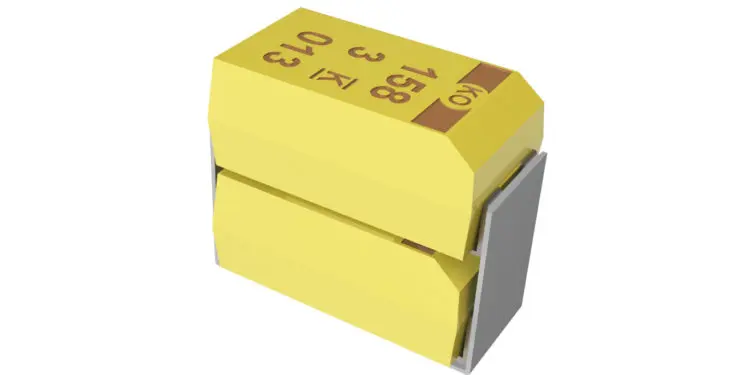Kemet electronics is introducing new O case size in TSM Series (T541 and T543) for tantalum polymer stacks. The new released extension is offering improved volumetric efficiency mainly for the defense and aerospace market.
Tantalum polymer capacitors are expanding their market share in the defense and aerospace market because they offer superior electrical performance (primarily much lower ESR), have outstanding reliability, and display a more benign failure response than the incumbent MnO2-cathode tantalum capacitor technology.
It is normal that engineers want to use this new technology in high reliability applications. It is expected that during the next four (4) years the adoption of this technology will increase by 22% (compared with 2019 data).

Polymer technology can offer significant advantages and savings over traditional tantalum capacitors and other solutions as MLCC’s or Electrolytic components. They have lower voltage de-rating, provide good volumetric efficiency, which is complemented with ultra-low ESR and ESL, so ripple current ratings are significantly improved. The capacitance range at discrete level can go up to 1,500 µF and rated voltages from 2.5 to 63 VDC. The ESR can be as low as 5 mOhms and ripple current ratings can be 4 to 5 times higher than traditional MnO2 tantalums.
Ta polymer capacitors are solid state capacitors that demonstrate no wear out mechanisms when operated within their recommended guidelines. While they can be operated at full rated voltage, most circuit designers seek a minimum level of assurance in long term reliability, which should be demonstrated with data.
A voltage derating can provide the desired level of demonstrated reliability based on industry accepted acceleration models. Capacitance is not impacted by bias and it is a suitable technology for high reliability applications that follow the actual trend of higher switching frequencies with better performance in terms of capacitance roll off.

Defense and aerospace application requirements are changing fast. In space segment, ultra-low ESR is the main drivers and defense designers are searching for solutions that can combine the lowest ESR (single digit level) with the highest capacitance possible for power rails from 28 V up to 50 V. the derating capability offered by polymer technology becomes the preferred solution in this scenario. In Fig. 3, the differences between the standard Tantalum (MnO2) with a derating of 50% are compared with the new landscape of power lines for tantalum polymer technology, requiring only 10% to 20% voltage derating.

Hi-Rel polymer series, are the first polymer electrolytic capacitors available with failure rate options as defined by KEMET’s KO-CAP Reliability Assessment method. This method utilizes accelerated conditions (voltage and temperature) applied to board-mounted samples to assess long term device reliability. The failure rates available are B (0.1% per 1,000 hours), C (0.01% per 1,000 hours), and D (0.001% per 1,000 hours). The KO-CAP Reliability Assessment method was developed as a result of over 10 years of research to find a solution for reliability grading of polymers since Weibull grading as per MIL-PRF-55365 is often ineffective when applied to this technology. Because this well-established tool often proves ineffective, the new reliability assessment strategy was needed to be developed by KEMET (applicable to T540 and T541 Series) and for the new MIL-PRF-POLY T580 and T581 Series.
With significant success in Defense and Aerospace market, typical applications for polymer tantalum capacitors include, decoupling, hold-up, and filtering. In addition, the T540/T541 and T543 Polymer HRA stack devices can be utilized in defense and aerospace equipment’s, including, High Power Amplifiers for radars and multiple applications where GaN active components are a part of the design.

High capacitance is a requirement for these applications and KEMET’s TSP (Tantalum Stack Polymer) becomes a viable solution when there are space limitations on the PCB but adequate headroom to accommodate the height of the TSP Series. This is driven by the need to build large charge storage banks.
KEMET has available multiple configurations for stacking, different case sizes and applicable to most of existing series available (including MnO2 – TSM Series).

With the introduction of the new O case size in TSM Series (T541 and T543) and TSP series, improved volumetric efficiency became available to the defense and aerospace market. The O case, is an EIA (7360-43) with the following mechanical specifications:

This new case size extends the offer of capacitance to each rated voltage level and in parallel with the ESR reduction of these new part numbers. Below, the extension of T541 values, is presented (from X case to O case).

The TSP series has two available configurations using the discrete O case size:
TSP2 – Two (2) discrete capacitors

Example of a high runner (2O) part number:

TSP4 – Four (4) discrete capacitors

Example of a high runner (4O) part number:

Conclusion
KEMET’s TSP (Tantalum Stack Polymer) capacitors are the most efficient solution when engineers need to design a high energy source for signal power amplification. With the highest volumetric efficiency available and the unique ultra-low ESR performance in a high reliability application, this product is an ideal solution for the described use scenario. Rated voltage levels are aligned with the today’s requirements for Vdd bias (typical levels of 28V up to 60V) offering high capacitance stability in a wide range of voltage and temperature.































